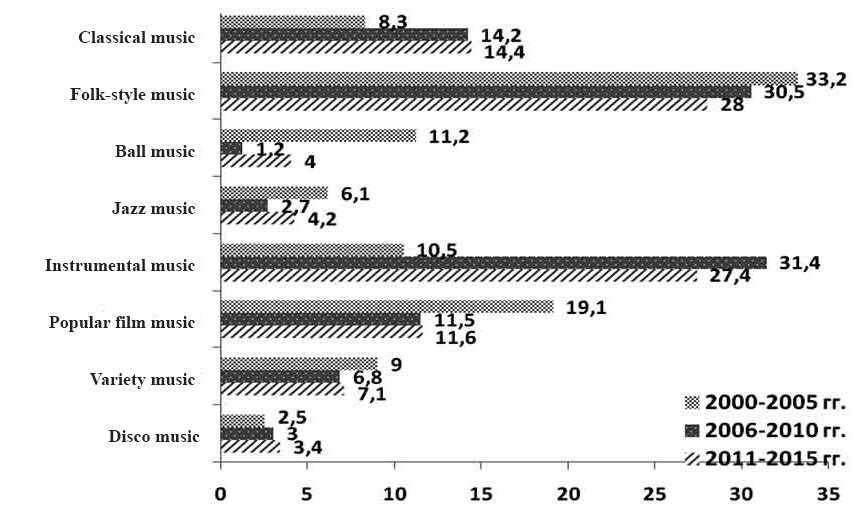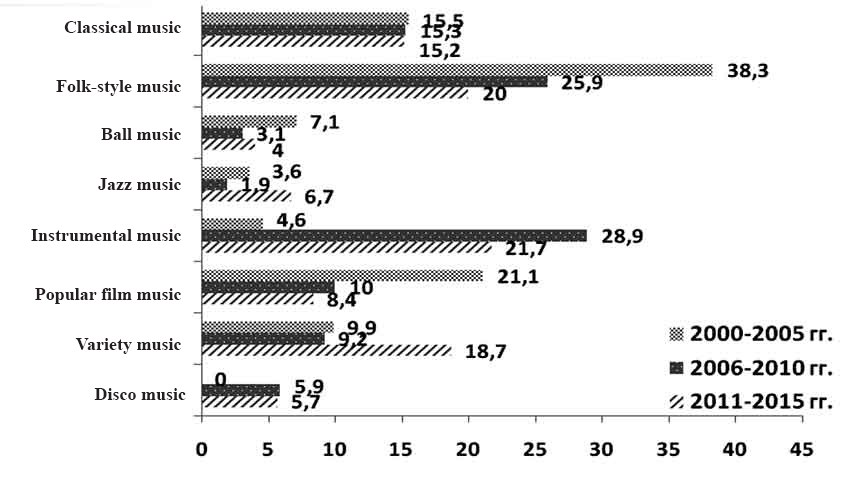Background music in competitive artistic and rhythmic gymnastics: roles and styles
Фотографии:
ˑ:
Professor, Dr.Hab. O.G. Rumba1
J.R. Nigmatulina2
1Military Institute of Physical Culture, St. Petersburg
2Peter the Great St. Petersburg Polytechnic University, St. Petersburg
Keywords: technical-and-artistic sports, background music, artistic gymnastics, rhythmic gymnastics, competitive routine, virtues of background music.
Introduction
Effects of background music in the technical-and-artistic sport (TAS) disciplines may be considered in two major domains that are the technical (compositional) and artistic (creative) ones [4]. There are quite a few sport disciplines today including artistic gymnastics, rhythmic/ aesthetic gymnastics, acrobatics, aerobics, figure skating, synchronized swimming, parquet sport dancing etc. that are no more imaginable without a musical styling component that has evolved into an integral part of the training processes, competitive events and demonstration routines.
Technical aspects of the background music in the TAS may be interpreted as largely connected with the music rhythms that are basically intended to harmonize the movements and compose them into a sound ensemble. As formulated by L.P. Voskresenskaya [1], it is the athlete’s ability to apprehend and interpret the rhythms specific for one or another routine that allows the movement sequences being refined to perfection within the frame of certain standards (e.g. in artistic gymnastics, dives, some athletic disciplines). To put it in other words, rhythm may be viewed as a sort of guide or coordinator structure that helps build up and harmonize the movement sequences; and the technical side of a musical background in this context may evolve into an important component of a few other sport disciplines too [5].
Artistic aspect of the background music in the TAS is dominated by the creative striving to form an impressive composition driven by the nature, content and design of the music itself, i.e. its style and images and emotions it refers to. Meanings of such terms as the music-driven movements or musicality in the artistically sensitive sports tend to go beyond the frame of the purely physical harmonization of the movement sequences with the musical background – as they imply the movement structure on the whole being harmonized with the supporting musical artwork in the styles, ideas and feelings.
In view of the above dual nature and importance of the background music in the TAS, it is natural that it will be selected and designed so as to be optimally tailored to every specific routine to support the competitive composition being harmonically and successfully lined up in both the technical and artistic aspects [2]. It should be mentioned in this context that the modern rules of competitions in every artistic sport discipline set requirements to the technical and artistic qualities of the competitive routines and background music, and the requirements to the musically backed content and qualities may be lined up as musicality – composition – expressivity.
Musicality in this context means the physical harmonization of the movement sequences with musical rhythms, conditional on the artistic content of the both being agreed.
Well designed composition implies, first of all, the routine elements being positioned in space and time in line with the background music piece; and, second, the design and style of the routine being harmonized with that of the background music piece.
Expressivity may be measured by the athlete’s ability and mastery in relaying the feelings and flavors of the background music in harmony with the technical side of the routine.
It should be emphasized in this context that the above requirements are designed on assumption of the music forming an integral part of a competitive routine, and this is the reason why it is the choice of the musical background that sets the frame content and styles for activities of the routine designer, coach and gymnast and determines success of the technical and artistic lines being harmonized in the final composition. Therefore, we believe that it may be beneficial to explore the meanings and content of the musical backgrounds in the TAS to outline the trends in the modern musical preferences, assess the music and choreography agreement standards and outline the accessible and beneficial expressivity tools.
Objective of the study was to identify the music styles most beneficial as backgrounds for the competitive routines in artistic and rhythmic gymnastics in the context of the expressivity standards and tools.
Methods and structure of the study. Subject to the study were the artistic and rhythmic gymnastics as case sports to explore the values and effects of background music in competitive routines. Analyzed in the rhythmic gymnastics were the competitive compositions; and in the artistic gymnastics – only the women’s free exercises as a single competitive discipline backed by soundtracks. Special subject to analysis were the video records of the major competitive events for the period of 2000-2015, including Olympic Games, World/ European Championships, World Cup events and Russian Championships. We have analyzed in total 28 artistic gymnastics events (969 compositions) and 44 rhythmic gymnastics events (2563 compositions in total). The data obtained in the study were sorted out into the following three groups:
- Data of 2000-2005: 10 artistic gymnastics competitions including 277 compositions; and 8 rhythmic gymnastics events including 394 compositions [3];
- Data of 2006-2010: 9 artistic gymnastics competitions including 338 compositions; and 22 rhythmic gymnastics events including 915 compositions; and
- Data of 2011-2015: 9 artistic gymnastics competitions including 354 compositions; and 14 rhythmic gymnastics events including 1254 compositions.
Study results and discussion. Having analyzed the video records of the major events in artistic and rhythmic gymnastics for the last 15 years, we would classify the musical backgrounds of the competitive routines into the following eight style classes: (1) classical music; (2) folk-style music; (3) ball music; (4) jazz music; (5) instrumental music; (6) popular film music; (7) variety music; and (8) disco music. It should be noted that dominating in both of the sport disciplines were the folk-style, instrumental, classical and popular film music. As verified by our analysis, for instance, 30.6% of the artistic gymnastics routines and 28.1% of the rhythmic gymnastics ones were backed by folk-style music tracks in the period under the study. However, there is a clear trend of this music style getting less popular lately, as the figures contracted to 28% of artistic gymnastics routines and 20% of the rhythmic gymnastics ones backed by folk-style music in the latest study period of 2011-2015 (see Figures 1 and 2 hereunder).

Figure 1. Women’s free exercises in artistic gymnastics: background music rated by the styles and periods based on the video-record analysis, %

Figure 2. Rhythmic gymnastics events: background music rated by the styles and periods based on the video-record analyses, %
Instrumental music application rate was found to average 23.1% in the artistic gymnastics routines and 18.4% in the rhythmic gymnastics ones for the study period, with the overall popularity of this music style being notably on the rise for the last decade on the whole and for the period of 2006-2010 in particular, as up to 31.4% of the artistic gymnastics routines and 28.9% in the rhythmic gymnastics ones applied it for that time.
The rhythmic gymnastics favored classical music slightly less than the popular film music for the period; whilst the situation in artistic gymnastics was quite the contrary for the study period. In more specific terms, on average 12.3% and 15.3% of the artistic and rhythmic gymnastics routines, respectively, were backed by classical music; and the popular film music was used in 14.1% and 13.2% of the artistic and rhythmic gymnastics routines, respectively, for the study period. It may be pertinent to note that the classical music application rates stayed fairly even over the study period, with the trend being particularly expressed in the rhythmic gymnastics (about 15% of the total routines); whilst the popular film music application rates showed some sagging trend as they dropped to 11.6% and 8.4% of the artistic and rhythmic gymnastics routines, respectively, for the latest period of 2011-2015.
Other music styles application rates were found to vary under 10%, with the only exclusion for the variety music in the rhythmic gymnastics routines; as its popularity for the last five years were on the rise and has come to as much as 18.7% that is quite close to the instrumental and folk-style music popularity rates.
The identified trends in the background music application for the study period were driven, in our opinion, by some natural logic, as the folk-style music, for instance is most easy for practical application in routines with the specific elements of the folk traditions being organically interwoven into the choreographic design of the relevant parts of the dance on the whole (emphasized by nods of the head, arm movements, folk dancing positions and elements etc.) and specific dancing sequences in particular. In addition, the creative image may be easily and successfully stressed by the folk-styled outfits of the gymnasts making reference to the national dressing traditions. Furthermore, it is no less important that the folk-style music is always rated among the most recognizable ones by the audience (regardless of age and sex structure of spectators), and this recognition may largely contribute to the certain emotional environment created during the routine.
Classical music, in its turn, refers first of all to the highest standards of human musical culture that tend to uplift and enrich the routine and have the relevant tuning effect on both the audience and the gymnast. When the gymnast, among other things, demonstrates high choreographic standards and excellent movement culture, there is always a great probability that the movement sequences will look very advantageous and well harmonized with the classical music.
As for the instrumental, popular film and variety music styles, they are always recognizable by the spectators – all the more that the melodies are often very popular and easily trigger feelings and associations that may be beneficial for success of the routine. Moreover, these music styles more often than not combine catching rhythmic arrangements with expressively lined melodies – with the rhythms and melody emphasizing the technical and artistic aspects of the competitive routine, respectively.
Ball music has been relatively seldom applied in the routines for the study period, and the most likely reason for that might be the high music/ movement/ dress compliance standards that has been recently established in some sports including parquet sport dancing and, hence, in attitudes and expectations of the sport specialists. There is almost no chance for these high compliance standards being applied in and met by the other artistically sensitive sports and, therefore, a ball music background (like tango, waltz, foxtrot etc.) may put the gymnast in a disadvantaged position per se.
Jazz music has also been relatively seldom favored for the period, and it might be due to the complicated uneven rhythmic structure of this music style as such – that is always highly challenging both in the routine design process and the competitive performance aspects.
Disco music has been in very limited use too for the study period, and we believe it might be largely due to its relatively poor expressive potential. Such music style may be beneficial in terms of convenient pace and rhythm of the movement sequences performed by the gymnast – and, hence, may help demonstrate every side of the technical skills; but it gives virtually no chance to relay highly emotional images to the audience in competitions.
Conclusions
Our analysis of the background music styles in the artistic and rhythmic gymnastics for the period of 2000 through 2015 demonstrates the preference being given by the sport communities to the folk-style, instrumental, classical and popular film music. These preferences have been apparently dominated by the high emotional and expressive potential of these music styles favorable for the artistic images that may be created and colored by a few minute lines – and this is very important in the context of the growing complexity and intensity of the modern competitive routines. This is the reason for these background music styles expected to be in growing demand by the gymnastics, in our forecasts; with the variety music expected to be also on the rise as a highly promising background for these sports (we would note the already visible growing trend for this music style application in rhythmic gymnastics); and this is particularly true for the top popular soundtracks with their high associative potential.
The study data breakdown by the five-year periods gave the means, on the one hand, to verify the top priority being given to the above background music styles; and, on the other hand, showed variations in their actual application rates over time. The variations may be due, in our opinion, to the coaches and gymnasts striving to update their favorite routines in both the technical and artistic aspects.
It may be pertinent to note at the end the modern trend of different special sound effects being applied to color and attune the main soundtrack. Such initiatives may be reasonable and appropriate when dictated by the actual needs and taste, albeit it is not unusual that too high passion for such effects makes some soundtracks unrecognizable and, hence, the favorite music pieces lose their identity. As a result, every musical background in the competitions may sound much the same as the others, and the gymnastics routines on the whole may follow suit losing their identity as well, and all that is of highly negative effect on the routine performance expressivity on the whole in fact.
References
- Voskresenskaya L.P. Issledovanie roli chuvstva ritma v povyshenii tekhnicheskogo masterstva sportsmenov: avtoref. dis. … kand. ped. nauk (Sense of rhythm to enhance technical skills of athletes: abstract of PhD thesis) / L.P. Voskresenskaya. – Moscow, 1969. – 14 p.
- Karpenko L.A. O vyrazitel'nosti, artistizme, emotsional'nosti v gimnastike (Expressiveness, artistry, emotions in gymnastics) / L.A. Karpenko, O.G. Rumba // Vestnik sportivnoy nauki. – 2013. – № 3. – P. 14–17.
- Karpenko L.A. Sportivno-massovoe napravlenie v razvitii sovremennoy khudozhestvennoy gimnastiki (Mass development of modern rhythmic gymnastics) / L.A. Karpenko, J.R. Nigmatulina // Teoriya i praktika fiz. kultury. – 2015. – № 2. – P. 42–44.
- Rumba O.G. Osobennosti muzykal'nogo soprovozhdeniya sorevnovatel'nykh programm po sportivnym vidam gimnastiki (Features of musical accompaniment of competitive programs in artistic gymnastics) / O.G. Rumba // Gymnastics: collected research; ed. by R.N. Terekhina, N.N. Vengerova, L.V. Lyuik. – St. Petersburg: SPbSUPhC n.a. P.F. Lesgaft, 2006. – Is. 4. – P. 78–83.
- Rumba O.G. O «tekhnicheskom» i «khudozhestvennom» naznacheniyakh muzykal'nogo soprovozhdeniya v tekhniko-esteticheskikh vidakh sporta ("Technical" and "artistic" purposes of musical accompaniment in technical aesthetic sports) / O.G. Rumba // Kul'tura fizicheskaya i zdorov'e. – 2007. – Is. 4(14). – P. 57–59.
Abstract
The article explores why optimally chosen musical background is so important in the technical and artistic performance of competitive routines being harmonized in the context of the dual role (technical and artistic) of the background music in technical-and-artistic sports. In order to determine trends in musical preferences and stipulate available means of plastic expression in technical and artistic sports the authors studied the specifics of the background music in competitive routines in rhythmic and artistic gymnastics for the past 15 years - from 2000 to 2015. The experimental sample was made of routines represented at 28 major artistic gymnastics (969 routines) and 44 rhythmic gymnastics (2563 routines) championships. The data obtained were distributed into three groups for retrospective analysis: 2000-2005, 2006-2010, 2011-2015. The study resulted in the conclusion on the preferential use of typical folk, instrumental, clas-sical music and soundtracks. It may be associated with high emotional expressive potential of this music, which helps the gymnast create a plastic image with minimal effort, which is very important in terms of increasing technical complexity and intensity of competitive routines.




 Журнал "THEORY AND PRACTICE
Журнал "THEORY AND PRACTICE